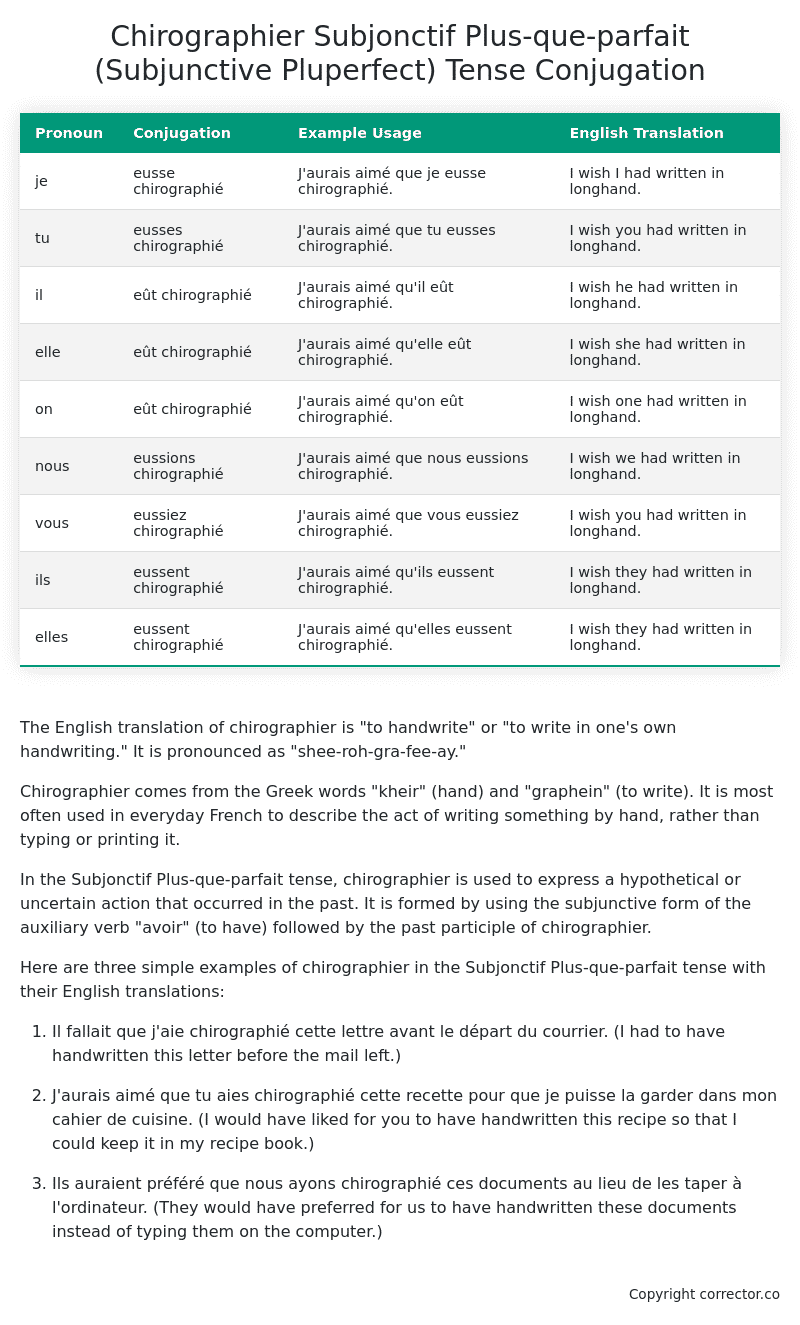Subjonctif Plus-que-parfait (Subjunctive Pluperfect) Tense Conjugation of the French Verb chirographier
Introduction to the verb chirographier
The English translation of chirographier is “to handwrite” or “to write in one’s own handwriting.” It is pronounced as “shee-roh-gra-fee-ay.”
Chirographier comes from the Greek words “kheir” (hand) and “graphein” (to write). It is most often used in everyday French to describe the act of writing something by hand, rather than typing or printing it.
In the Subjonctif Plus-que-parfait tense, chirographier is used to express a hypothetical or uncertain action that occurred in the past. It is formed by using the subjunctive form of the auxiliary verb “avoir” (to have) followed by the past participle of chirographier.
Here are three simple examples of chirographier in the Subjonctif Plus-que-parfait tense with their English translations:
-
Il fallait que j’aie chirographié cette lettre avant le départ du courrier. (I had to have handwritten this letter before the mail left.)
-
J’aurais aimé que tu aies chirographié cette recette pour que je puisse la garder dans mon cahier de cuisine. (I would have liked for you to have handwritten this recipe so that I could keep it in my recipe book.)
-
Ils auraient préféré que nous ayons chirographié ces documents au lieu de les taper à l’ordinateur. (They would have preferred for us to have handwritten these documents instead of typing them on the computer.)
Table of the Subjonctif Plus-que-parfait (Subjunctive Pluperfect) Tense Conjugation of chirographier
| Pronoun | Conjugation | Example Usage | English Translation |
|---|---|---|---|
| je | eusse chirographié | J’aurais aimé que je eusse chirographié. | I wish I had written in longhand. |
| tu | eusses chirographié | J’aurais aimé que tu eusses chirographié. | I wish you had written in longhand. |
| il | eût chirographié | J’aurais aimé qu’il eût chirographié. | I wish he had written in longhand. |
| elle | eût chirographié | J’aurais aimé qu’elle eût chirographié. | I wish she had written in longhand. |
| on | eût chirographié | J’aurais aimé qu’on eût chirographié. | I wish one had written in longhand. |
| nous | eussions chirographié | J’aurais aimé que nous eussions chirographié. | I wish we had written in longhand. |
| vous | eussiez chirographié | J’aurais aimé que vous eussiez chirographié. | I wish you had written in longhand. |
| ils | eussent chirographié | J’aurais aimé qu’ils eussent chirographié. | I wish they had written in longhand. |
| elles | eussent chirographié | J’aurais aimé qu’elles eussent chirographié. | I wish they had written in longhand. |
Other Conjugations for Chirographier.
Le Present (Present Tense) Conjugation of the French Verb chirographier
Imparfait (Imperfect) Tense Conjugation of the French Verb chirographier
Passé Simple (Simple Past) Tense Conjugation of the French Verb chirographier
Passé Composé (Present Perfect) Tense Conjugation of the French Verb chirographier
Futur Simple (Simple Future) Tense Conjugation of the French Verb chirographier
Futur Proche (Near Future) Tense Conjugation of the French Verb chirographier
Plus-que-parfait (Pluperfect) Tense Conjugation of the French Verb chirographier
Passé Antérieur (Past Anterior) Tense Conjugation of the French Verb chirographier
Futur Antérieur (Future Anterior) Tense Conjugation of the French Verb chirographier
Subjonctif Présent (Subjunctive Present) Tense Conjugation of the French Verb chirographier
Subjonctif Passé (Subjunctive Past) Tense Conjugation of the French Verb chirographier
Subjonctif Imparfait (Subjunctive Imperfect) Tense Conjugation of the French Verb chirographier
Conditionnel Présent (Conditional Present) Tense Conjugation of the French Verb chirographier
Conditionnel Passé (Conditional Past) Tense Conjugation of the French Verb chirographier
L’impératif Présent (Imperative Present) Tense Conjugation of the French Verb chirographier
L’infinitif Présent (Infinitive Present) Tense Conjugation of the French Verb chirographier
(this article)
Struggling with French verbs or the language in general? Why not use our free French Grammar Checker – no registration required!
Get a FREE Download Study Sheet of this Conjugation 🔥
Simply right click the image below, click “save image” and get your free reference for the chirographier Subjonctif Plus-que-parfait tense conjugation!

Chirographier – About the French Subjonctif Plus-que-parfait (Subjunctive Pluperfect) Tense
Formation
Common Everyday Usage Patterns
Hypothetical Situations
Reported Speech
Doubt, Wishes, and Emotions
Interactions with Other Tenses
Present Subjunctive
Imperfect Subjunctive
Conditional
Summary
I hope you enjoyed this article on the verb chirographier. Still in a learning mood? Check out another TOTALLY random French verb conjugation!


